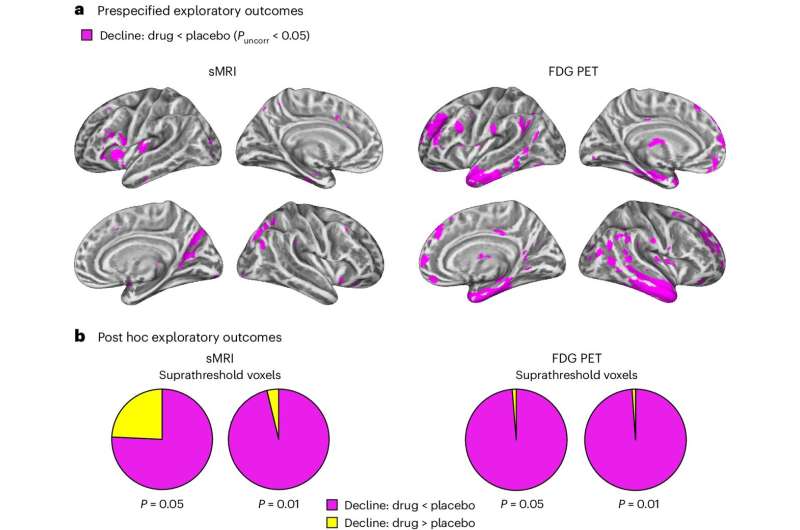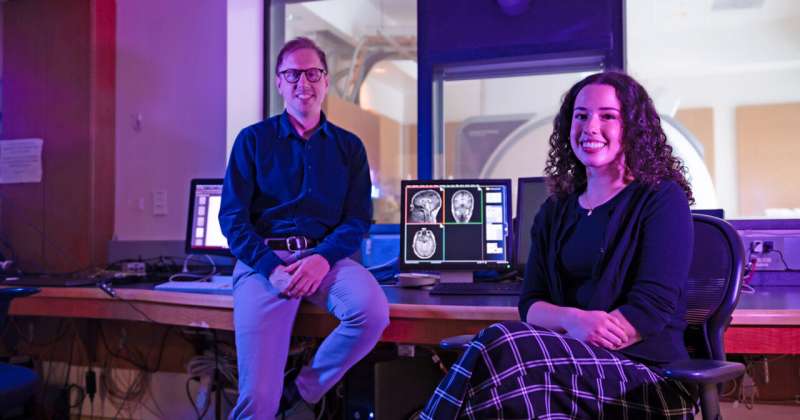This article has been reviewed according to Science X's editorial process and policies. Editors have highlighted the following attributes while ensuring the content's credibility:
fact-checked
peer-reviewed publication
trusted source
proofread
Results from first human clinical trial offer promising early results for new Alzheimer's treatment

Alzheimer's disease is the most common cause of dementia, affecting more than 55 million people worldwide. Currently, the two main approaches for treatments to delay or slow its progression target the buildup of amyloid beta peptides—which form plaques in the spaces between nerve cells in the brain—and the buildup of tau protein, resulting in tangles which damage neurons.
However, these strategies only single out a narrow set of Alzheimer's disease-related biological markers and mechanisms.
Findings from a clinical trial, led by a team of researchers from Western University, Stanford University and University of California, San Francisco (UCSF), were recently published in Nature Medicine.
The team evaluated a new drug for enhancing the brain's resilience to changes driven by Alzheimer's, showing promising results for patients with mild to moderate forms of the disease in its first human trial.
The drug LM11A-31, developed by Stanford professor Dr. Frank Longo and UCSF professor Dr. Stephen Massa, targets the P75 neurotrophin receptor (P75NTR), located on cells in the brain. P75NTR helps regulate various processes like cell survival, growth and death—like a traffic controller, deciding which signals get through and which don't. The drug enhances the passage of signals which promote cell survival and growth.
In 2020, the developers of the drug reached out to Schulich School of Medicine & Dentistry professor Taylor Schmitz and Hayley Shanks, a neuroscience Ph.D. student at Schulich Medicine & Dentistry, to analyze the structural MRI data from their phase 2A clinical trial. Their analyses ultimately grew to include positron emission tomography (PET) and cerebrospinal fluid data.

Although the trial's primary purpose was to evaluate the safety and tolerability of the drug in patients with mild to moderate Alzheimer's, researchers also collected multiple markers of brain pathology to assess whether the drug affected disease progression between baseline and follow-up tests, when compared to placebo. The trial met its primary goals to show safety and tolerability.
The team at Western led the analysis of the trial. Despite the relatively short 26-week duration, they demonstrated that the drug slowed disease progression on multiple measures.
"In a phase 2A clinical trial, the objective is to demonstrate that the drug is not causing side effects that would be toxic," said Schmitz, lead author.
The researchers are hopeful the drug can benefit patients even when applied at later stages of the disease. Current treatments, such as amyloid monoclonal antibodies, that try to clear amyloid from the brain are not as effective for patients in the later stages of Alzheimer's disease because the amyloid has already caused significant damage to the neurons.
"The reason this drug is exciting is because it's directly affecting the ability of the neurons to survive. It promotes their overall integrity, their branching and their synapses [where they connect and communicate with each other]," said Shanks.
"In animal models, it was shown that the drug was preserving these neurons or reversing the damage to these neurons which translated to behavioral improvements, almost reverting the neurons back to a healthy state."
This clinical trial represents the first instance of targeting the P75 neurotrophin receptor in a human disease population after 10 years of preclinical work. The trial, conducted in five European countries, involved 242 participants living with mild to moderate Alzheimer's disease.
"We also observed changes in an inflammation biomarker. The drug slowed down the increase of this inflammation marker in the cerebrospinal fluid," said Schmitz. "This is significant because, in the past five years, inflammation has become a key factor in understanding Alzheimer's disease."
Seeing these results this early on is significant and promising. Most phase 3 trials for Alzheimer's therapeutics take approximately two years, and in the six-month interval used in the latest trial, movement of this degree is not usually seen.
In this phase 2 trial, there were significant changes in two synaptic biomarkers taken from the cerebral spinal fluid within a six-month period, explained Schmitz.
"This builds confidence that what we're seeing is something real, rather than a false positive," added Shanks.
At Western, further studies are currently underway to examine the drug using state-of-the-art animal models of Alzheimer's disease in combination with high-resolution brain imaging on the new 15.2 Tesla MRI at the Center for Functional and Metabolic Mapping at Robarts.
These studies will help to improve the efficiency and effectiveness of larger human trials by providing information on what point during the disease it is best to initiate treatment and whether certain Alzheimer's risk genes may affect treatment response.
"An important part of the study was the collaboration of multiple independent experts in the areas of brain imaging and biomarkers. It is of particular interest that this treatment approach appears to be engaging basic mechanisms of resilience and integrity of the synaptic connections between brain cells," said Longo.
"We look forward to being able to launch a larger trial that will further test effects on cognition and quality of life."
If proven effective in future trials, this drug could help to slow Alzheimer's progression in a wide range of patients due to its effects on multiple different types of pathology, its accessibility—it is taken orally—and its safety from potentially hazardous side effects.
More information: Hayley R. C. Shanks et al, p75 neurotrophin receptor modulation in mild to moderate Alzheimer disease: a randomized, placebo-controlled phase 2a trial, Nature Medicine (2024). DOI: 10.1038/s41591-024-02977-w





















